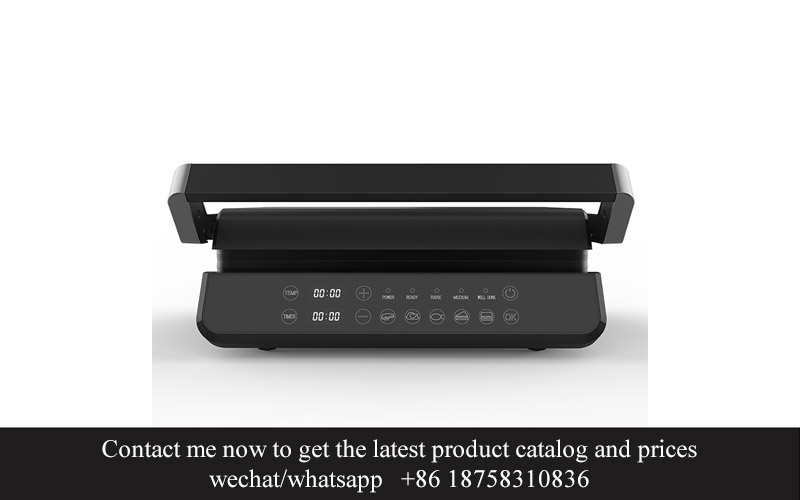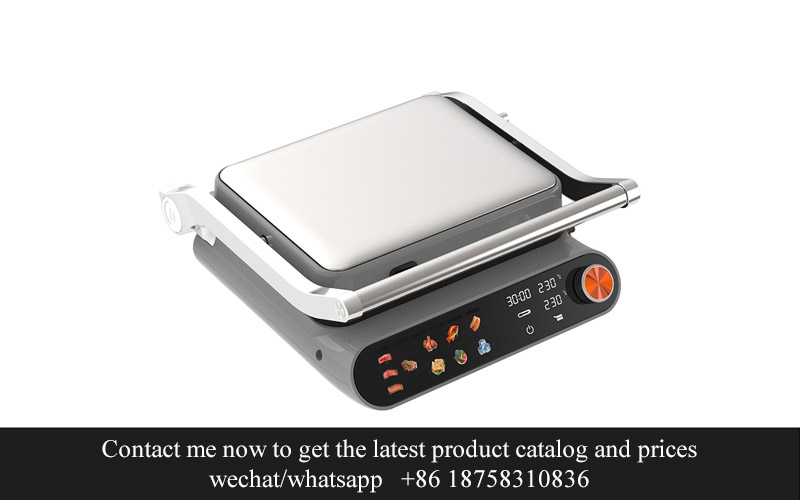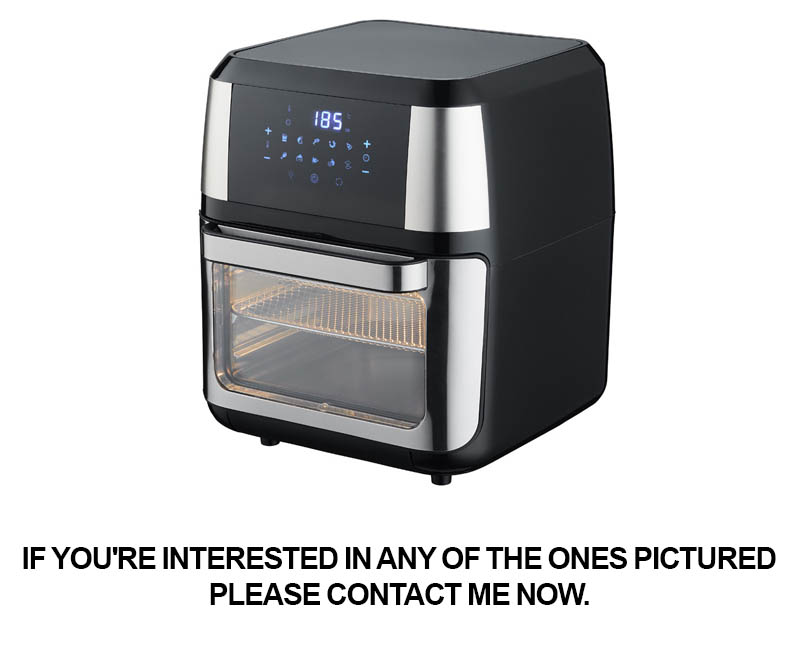Address
304 North Cardinal
St. Dorchester Center, MA 02124
Work Hours
Monday to Friday: 7AM - 7PM
Weekend: 10AM - 5PM
Address
304 North Cardinal
St. Dorchester Center, MA 02124
Work Hours
Monday to Friday: 7AM - 7PM
Weekend: 10AM - 5PM

As the culinary landscape continues to evolve, the demand for efficient and innovative kitchen equipment grows stronger. Among these advancements, the continuous operation sandwich grill plant has emerged as a beacon of efficiency and productivity, reshaping the commercial kitchen industry. This article delves into the innovative features and benefits of these grill plants, their impact on efficiency and productivity, and the exciting future they promise for the industry.
In the bustling world of commercial kitchen equipment, the continuous operation sandwich grill plant has emerged as a game-changer, redefining the way we think about fast and efficient food service. These innovative units are designed to operate seamlessly, providing a non-stop flow of perfectly toasted sandwiches and other grill-based delights. Let’s delve into the fascinating world of continuous operation sandwich grill plants and explore their significance in today’s dynamic food industry.
These sandwich grill plants are engineered to handle high volumes of food production with unparalleled efficiency. Their design allows for a constant supply of fresh, hot sandwiches, making them ideal for busy cafes, fast-food chains, and even self-service stations. The key to their success lies in their ability to maintain a steady pace, ensuring that no customer is left waiting for their meal.
At the heart of these sandwich grill plants is a sophisticated heating system that guarantees even and consistent cooking. This technology ensures that each sandwich is toasted to perfection, with a golden-brown crust and a warm, melty interior. The continuous operation aspect is not just about speed; it’s about the consistent quality that keeps customers coming back for more.
One of the standout features of these plants is their modular design. This allows for easy integration into existing kitchen layouts or customization to meet specific operational needs. Whether you’re a small café or a large commercial kitchen, these sandwich grill plants can be tailored to fit your space and workflow.
The efficiency of continuous operation sandwich grill plants is not just limited to speed; it extends to energy consumption as well. These units are designed to optimize energy usage, reducing operational costs and minimizing the environmental impact. This focus on sustainability is a crucial factor in the foodservice industry’s ongoing commitment to eco-friendly practices.
The ease of use is another key advantage of these sandwich grill plants. With intuitive controls and simple maintenance requirements, they are a breeze to operate. Staff training is minimal, and the units can be up and running quickly, allowing for a shorter return on investment.
In terms of versatility, these sandwich grill plants can handle a wide range of ingredients and preparation methods. From classic ham and cheese to gourmet creations with fresh vegetables and gourmet toppings, the possibilities are endless. This flexibility ensures that foodservice operators can cater to diverse tastes and preferences without compromising on quality or speed.
Safety is also a top priority in the design of continuous operation sandwich grill plants. With features like automatic shut-off mechanisms and non-slip surfaces, these units are designed to prevent accidents and maintain a safe working environment. This peace of mind is invaluable for busy kitchens where accidents can lead to costly downtime and potential harm to employees.
The market for continuous operation sandwich grill plants is expanding rapidly, driven by the demand for fast, high-quality food service. As the industry evolves, we’re seeing a shift towards more advanced technologies and innovations. For instance, some models now come equipped with smart sensors that can adjust cooking temperatures and times based on the specific food being prepared, further enhancing efficiency and quality control.
Moreover, the integration of these plants with other kitchen equipment is becoming more seamless. For example, a continuous operation sandwich grill plant can be paired with automated bread slicing systems, filling stations, and packaging machines to create a fully automated sandwich production line. This integration not only increases speed but also reduces the need for manual labor, making operations more efficient and cost-effective.
As we look to the future, it’s clear that continuous operation sandwich grill plants will continue to play a pivotal role in the commercial kitchen landscape. The industry is witnessing a trend towards more intelligent, connected kitchen equipment that can adapt to changing demands and optimize production. These plants are not just cooking equipment; they are part of a larger ecosystem that is shaping the future of foodservice.
In conclusion, the continuous operation sandwich grill plant represents a significant advancement in the world of commercial kitchen equipment. With their efficiency, versatility, and commitment to quality, these units are well on their way to becoming an indispensable part of the modern kitchen. As the industry continues to evolve, embracing these technologies will be crucial for any establishment aiming to stay competitive and meet the expectations of today’s fast-paced, food-loving consumers.

The commercial kitchen equipment market has seen a significant transformation with the rise of continuous operation sandwich grill plants. This shift is not just a fleeting trend but a testament to the evolving needs of the foodservice industry. As consumer demands grow for speed, efficiency, and consistency, these grill plants have emerged as the new standard in commercial kitchens.
The demand for quick-service restaurants (QSRs) and fast casual dining has surged, and with it, the need for high-speed cooking solutions. Continuous operation sandwich grill plants are designed to meet these demands head-on, offering a non-stop cooking process that can keep up with the fast-paced environment of modern restaurants.
One of the key drivers behind this rise is the increasing competition in the foodservice sector. Operators are constantly seeking ways to differentiate themselves and attract customers, and a continuous operation sandwich grill plant can be a significant differentiator. These grills can handle high volumes of sandwiches and other food items in a short amount of time, allowing restaurants to serve more customers without sacrificing quality.
The technology behind these grill plants is also a crucial factor. They are engineered with advanced heating systems that maintain consistent temperatures throughout the cooking process, ensuring that each sandwich is cooked to perfection. This level of precision is difficult to achieve with traditional grills, which often require manual adjustments to maintain uniformity in the food output.
Moreover, the energy efficiency of continuous operation sandwich grill plants cannot be overstated. These units are designed to minimize energy consumption while maximizing output, which is a critical consideration for any commercial kitchen looking to reduce operational costs. In an era where sustainability is more than just a buzzword, these grills offer a greener alternative to traditional cooking methods.
Another factor contributing to the popularity of continuous operation sandwich grill plants is their ease of maintenance. With fewer moving parts and a streamlined design, these grills require less frequent maintenance and downtime compared to their predecessors. This not only saves on labor costs but also ensures that the kitchen remains operational, providing uninterrupted service to customers.
The modular nature of these grill plants is also a significant advantage. They can be customized to fit the specific needs of a restaurant, whether it’s a small café or a bustling food court. This flexibility allows for a seamless integration into existing kitchen layouts or the creation of entirely new cooking lines.
As the foodservice industry continues to evolve, there’s a growing emphasis on innovation and technology. Continuous operation sandwich grill plants are at the forefront of this innovation, with manufacturers constantly seeking to improve upon existing models. Features like automated cleaning systems and smart temperature control are becoming more common, further enhancing the efficiency and reliability of these grills.
The rise of these grill plants has also had a ripple effect on the supply chain. As demand increases, suppliers are stepping up to provide the necessary components and parts, ensuring that operators can maintain their equipment with ease. This has also led to the development of a more specialized market for parts and service, catering specifically to the needs of continuous operation sandwich grill plants.
In conclusion, the surge in continuous operation sandwich grill plants in the commercial kitchen equipment market is a clear indication of the industry’s direction. With their ability to handle high volumes, maintain consistent quality, and offer energy-efficient solutions, these grills are becoming an indispensable part of modern commercial kitchens. As the industry continues to evolve, it’s likely that we’ll see even more advancements in this area, making continuous operation sandwich grill plants an even more integral part of the foodservice landscape.

The sandwich grill plant has emerged as a cornerstone in the commercial kitchen equipment market, offering a range of features and benefits that have revolutionized the way foodservice operators prepare sandwiches. At its core, a sandwich grill plant is designed for continuous operation, ensuring a seamless and efficient workflow in busy kitchens. Let’s delve into the key aspects that make these grills stand out.
Efficient Heat DistributionOne of the most significant features of a sandwich grill plant is its advanced heat distribution system. These grills are engineered to maintain consistent temperatures across the entire cooking surface, ensuring that every sandwich is cooked to perfection. The even heat distribution is achieved through a combination of precise heating elements and insulation, which prevents hotspots and cold spots that can compromise the quality of the final product.
Automated Cooking ProcessThe heart of a sandwich grill plant lies in its automated cooking process. These grills are equipped with programmable settings that allow operators to set specific cooking times and temperatures for different types of sandwiches. From the golden-brown toasted bread to the perfectly melted cheese, the grill ensures that each component of the sandwich receives the right amount of heat, resulting in a deliciously consistent outcome every time.
Large Cooking CapacityThe commercial kitchen environment demands high throughput, and a sandwich grill plant is designed to meet these needs. With spacious cooking surfaces that can accommodate multiple sandwiches at once, these grills significantly reduce the time required to prepare large quantities of food. This feature is especially beneficial in fast-food restaurants, delis, and cafeterias where speed of service is crucial.
Ease of Cleaning and MaintenanceMaintaining cleanliness and hygiene in a commercial kitchen is paramount, and the sandwich grill plant addresses this concern with its easy-to-clean design. The non-stick surfaces and removable parts make it a breeze to wipe down and sanitize, reducing the risk of cross-contamination and keeping the grill in top condition for extended use.
Customizable Cooking ProfilesUnderstanding that no two sandwich recipes are the same, sandwich grill plants offer customizable cooking profiles. Operators can adjust the heat settings, cooking time, and even the amount of pressure applied during the cooking process to cater to specific menu items or customer preferences. This flexibility ensures that the grill can be tailored to any kitchen’s unique requirements.
Safety FeaturesSafety is a top priority in any kitchen, and sandwich grill plants are no exception. These grills are equipped with safety features such as automatic shut-off mechanisms, which activate if the grill is left unattended or overheats. Additionally, the cool-touch handles and non-slip feet provide a secure cooking environment, reducing the risk of accidents.
Energy EfficiencyIn an era where sustainability is a growing concern, energy efficiency is a key consideration. Sandwich grill plants are designed to minimize energy consumption while maintaining optimal cooking temperatures. The efficient heating elements and insulation technology not only save energy but also reduce utility costs for foodservice operators.
Versatility in Menu OfferingsThe versatility of a sandwich grill plant extends beyond just sandwiches. These grills can be used to cook a variety of items, including wraps, paninis, and even pizzas. The ability to handle different types of food means that a sandwich grill plant can be a multi-functional asset in the kitchen, enhancing the menu options without requiring additional equipment.
Reduced Labor CostsBy automating the cooking process and improving efficiency, sandwich grill plants can help reduce labor costs. The consistent quality of the sandwiches produced by these grills means that less time is spent on manual cooking and quality control. This efficiency allows staff to focus on other tasks, such as customer service or preparing other dishes.
In conclusion, the sandwich grill plant has become a staple in the commercial kitchen equipment market due to its array of features and benefits. From its efficient heat distribution and automated cooking process to its large cooking capacity and energy efficiency, these grills are a testament to the ingenuity of kitchen equipment technology. As the demand for high-quality, fast service continues to rise, the sandwich grill plant is poised to play a pivotal role in the future of the foodservice industry.

In recent years, the commercial kitchen equipment market has witnessed a surge in the popularity of continuous operation sandwich grills. These grills are not just a trend; they represent a significant shift in how foodservice establishments handle high-volume, consistent production. Let’s delve into the innovative designs that have made these grills a staple in busy kitchens.
Grill plates that adapt to various sandwiches are a hallmark of modern continuous operation sandwich grills. These plates are designed to accommodate different sizes and types of bread, ensuring that each sandwich is cooked evenly. The ability to switch between various breads and fillings without a lengthy cleanup process is a game-changer for fast-paced environments.
Intelligent temperature control systems are another key feature. These systems maintain precise temperatures throughout the grilling process, ensuring consistent results every time. The technology often includes digital displays that allow operators to easily adjust settings based on the specific requirements of the food being cooked. This level of control is crucial for maintaining quality and consistency in large batches.
The incorporation of non-stick surfaces has also revolutionized the design of continuous operation sandwich grills. These surfaces reduce the need for excessive oil or butter, making the grilling process healthier and more efficient. Additionally, they simplify the cleaning process, as food particles are less likely to stick, leading to quicker and easier maintenance.
Innovative heating elements are at the heart of these grills. Modern designs often feature high-efficiency heating elements that provide quick and even heat distribution. This not only speeds up the grilling process but also ensures that the heat is consistent across the entire surface of the grill plate, leading to perfectly toasted sandwiches every time.
The presence of adjustable cooking zones is a feature that caters to the diverse needs of sandwich preparation. Operators can tailor the heat output to different parts of the grill, which is particularly useful for sandwiches with various toppings or fillings that require different cooking times and temperatures.
Safety features have also seen significant advancements in these grills. Many models come equipped with automatic shut-off mechanisms that activate if the grill is left unattended or if it reaches unsafe temperatures. This not only protects the equipment but also minimizes the risk of accidents in the kitchen.
Ease of use is a priority in the design of continuous operation sandwich grills. User-friendly interfaces, such as intuitive control panels and simple one-touch operation, make it easy for staff to manage the grilling process without extensive training. This is especially beneficial in environments where staff turnover is high.
Efficiency is a key selling point for these grills. The ability to cook multiple sandwiches at once, with some models capable of handling up to 300 sandwiches per hour, means that these grills can significantly reduce wait times for customers. The rapid throughput is essential for maintaining a smooth operation in busy cafes, delis, and fast-food restaurants.
Energy efficiency is another important aspect of these grills. With advancements in heating technology, these grills consume less energy than traditional grills, which can lead to significant cost savings over time. The reduced energy consumption is not only good for the bottom line but also contributes to a more sustainable kitchen environment.
The design of continuous operation sandwich grills has also embraced the concept of modularity. Many models are designed to be easily integrated into existing kitchen layouts or expanded as the business grows. This flexibility allows for a grill that can adapt to the evolving needs of a foodservice establishment.
Lastly, the aesthetic appeal of these grills should not be overlooked. Modern designs often feature sleek lines and a compact footprint, making them a stylish addition to any kitchen. The clean and professional look of these grills can enhance the overall atmosphere of the dining area.
In conclusion, the innovative designs of continuous operation sandwich grills are a testament to the ongoing evolution of commercial kitchen equipment. From adaptive grill plates and intelligent temperature control to safety features and energy efficiency, these grills are equipped to meet the demands of today’s fast-paced foodservice industry. As technology continues to advance, we can expect even more innovative features that will further enhance the capabilities of these essential kitchen tools.

In the ever-evolving landscape of the commercial kitchen equipment market, the concept of continuous operation has emerged as a significant game-changer. This trend is reshaping the way businesses, particularly those in the fast-food and quick-service restaurant (QSR) sectors, approach their cooking operations. Let’s delve into the market trends that underscore why continuous operation is making such a profound impact.
The demand for speed and efficiency in foodservice operations has surged, driven by the rise of on-the-go consumers and the increasing competition among restaurants. Continuous operation sandwich grills are designed to meet these demands by providing a seamless and uninterrupted cooking process. This shift towards continuous operation is not just a fleeting trend; it’s a strategic move that addresses several key market trends.
One of the most notable trends is the emphasis on fast service. Customers today expect their food to be prepared and served quickly, especially in high-traffic environments like airports, train stations, and busy urban centers. Continuous operation sandwich grills are engineered to handle high volumes of orders without compromising on quality or speed. Their ability to cook multiple sandwiches simultaneously ensures that the line moves swiftly, reducing wait times and enhancing customer satisfaction.
Energy efficiency is another critical factor in the market. As businesses become more environmentally conscious and cost-aware, they are seeking out equipment that not only performs well but also operates with minimal energy consumption. Continuous operation sandwich grills are designed with energy-saving features, such as advanced heat retention systems and optimized heating elements, which not only reduce utility bills but also contribute to a greener operation.
Customization is also a driving force in the market. Modern consumers are looking for personalized experiences, and the foodservice industry is responding by offering a wider variety of menu items. Continuous operation sandwich grills can be equipped with modular components, allowing for quick adjustments to accommodate different types of bread, fillings, and cooking temperatures. This flexibility ensures that restaurants can cater to diverse customer preferences without the need for multiple grills or complex setups.
The integration of technology is another trend that’s reshaping the market. Modern sandwich grills are often equipped with digital controls and smart interfaces that provide real-time data on cooking times, temperatures, and energy usage. This level of automation not only simplifies the operation but also allows for precise control over the cooking process, ensuring consistent quality and reducing the potential for human error.
The market is also witnessing a growing focus on food safety and hygiene. Continuous operation sandwich grills are designed with features that facilitate easy cleaning and maintenance, which is crucial in preventing cross-contamination and maintaining high food safety standards. The ability to quickly sanitize surfaces and change cooking elements is a significant advantage in environments where health codes are stringent.
Another key trend is the rise of mobile and pop-up restaurants. These businesses require portable, durable, and easy-to-use equipment. Continuous operation sandwich grills are often compact and lightweight, making them ideal for setting up in various locations, from temporary food festivals to long-term street food operations.
The market for continuous operation sandwich grills is also influenced by the global trend towards convenience. As people lead busier lives, there’s a greater demand for convenient meal options that can be prepared quickly and easily. Continuous operation grills enable restaurants to offer a variety of sandwich options that can be cooked to order, providing a convenient and satisfying meal solution for time-poor consumers.
The market trends in the commercial kitchen equipment sector are clear: continuous operation is not just a trend; it’s a necessity. It’s a response to the need for speed, efficiency, energy savings, customization, technology integration, food safety, and convenience. As the demand for these features grows, so does the importance of continuous operation sandwich grills in the market. They are becoming the cornerstone of modern foodservice operations, ensuring that businesses can keep up with the fast-paced world of foodservice while delivering high-quality, consistent, and fast meals to their customers.

In the fast-paced world of commercial kitchens, the ability to maintain a seamless workflow is crucial. Continuous operation sandwich grill plants have emerged as a game-changer, significantly impacting efficiency and productivity in various ways.
Grill performance is a cornerstone of continuous operation. These plants are designed with high-capacity heating elements that ensure consistent cooking temperatures, reducing the need for frequent adjustments and minimizing downtime. This means that as soon as one batch of sandwiches is finished, the grill is ready to start the next, keeping the line moving and the customers satisfied.
Energy efficiency is another key aspect. Continuous operation sandwich grill plants are engineered to use energy more effectively, often featuring advanced heat exchange systems that reduce energy consumption without compromising on cooking speed or quality. This not only cuts operational costs but also contributes to a greener, more sustainable kitchen environment.
The speed of these grills is unparalleled. With continuous operation, the sandwich production line can handle a higher volume of orders in a shorter time frame. The rapid cooking times mean that kitchens can serve more customers per hour, leading to increased revenue and improved customer turnover rates.
The design of continuous operation sandwich grill plants also enhances labor efficiency. By automating certain processes, such as the loading and unloading of sandwiches, these grills reduce the physical strain on kitchen staff. This allows chefs and kitchen staff to focus on other tasks, such as creating additional dishes or ensuring the quality of the sandwiches.
Sanitary maintenance is streamlined with continuous operation. These grills are often designed with easy-to-clean surfaces and features that minimize the risk of food contamination. Regular cleaning routines are simplified, allowing kitchen staff to spend less time on maintenance and more time on cooking and customer service.
The scalability of continuous operation sandwich grill plants is a significant benefit. Whether a kitchen is small or large, these grills can be tailored to fit the space and production needs. This flexibility means that as a business grows, the grill can be expanded or modified to meet the increasing demand, without a complete overhaul of the kitchen setup.
Another impact on efficiency and productivity is the reduction in waste. With precise temperature control and cooking times, these grills ensure that sandwiches are cooked to perfection every time, reducing the amount of food that is overcooked or undercooked and, consequently, wasted.
Training staff to operate continuous operation sandwich grill plants is also more straightforward. The intuitive interfaces and consistent performance of these grills make it easier for new employees to learn and contribute to the kitchen’s productivity quickly.
Moreover, the integration of these grills into existing kitchen layouts is often seamless. They can be designed to complement the workflow of the kitchen, whether it’s a busy café or a high-volume restaurant, without disrupting the established routines.
In conclusion, the impact of continuous operation on efficiency and productivity in sandwich grill plants is profound. From the speed and precision of cooking to the reduction in energy consumption and waste, these grills are redefining what’s possible in commercial kitchens. As the demand for quick and quality food continues to rise, the adoption of continuous operation sandwich grill plants is set to become a standard in the industry, driving kitchens towards greater productivity and profitability.

In a bustling café in downtown Manhattan, the introduction of a continuous operation sandwich grill plant revolutionized the way food was prepared and served. The seamless flow of fresh, hot sandwiches ensured that customers were not kept waiting, a stark contrast to the previous manual grilling process. This case study highlights the transformative impact of such a system on a small-scale business.
The plant’s design allowed for a constant production line, where ingredients were prepped, stacked onto buns, and then grilled in a high-speed, automated process. The efficiency was immediately noticeable, with a marked reduction in the time it took to produce each sandwich. The café saw a significant increase in customer satisfaction and a noticeable uptick in sales.
Similarly, a fast-food chain in the heart of Chicago replaced its traditional grills with a continuous operation sandwich grill plant. The new system not only reduced the time spent on each sandwich but also improved the consistency of the product. The ability to keep up with peak lunchtime demand was a game-changer, allowing the chain to serve more customers without overextending its staff.
In the competitive world of foodservice, the ability to maintain quality while increasing output is crucial. A trendy eatery in San Francisco decided to invest in a continuous operation sandwich grill plant to keep up with the demand for its signature sandwiches. The plant’s ability to handle multiple grilling stages at once meant that the kitchen could process orders more rapidly, ensuring that the line moved smoothly and patrons were served promptly.
The benefits of a continuous operation sandwich grill plant extend beyond just speed. A restaurant in Austin, Texas, found that the automated system greatly reduced the risk of burns and accidents, which was a significant improvement over the manual grilling method. The plant’s precise temperature control also meant that each sandwich was cooked to perfection, every time.
A sports stadium in Los Angeles was another venue that saw the value in a continuous operation sandwich grill plant. During high-profile events, the demand for food can skyrocket, and the traditional grilling setup simply couldn’t keep up. The plant allowed for a steady stream of sandwiches, keeping fans happy and preventing long lines. The stadium’s management was particularly impressed with the plant’s ability to operate without a break, ensuring that food was available throughout the duration of the event.
In the realm of healthcare, a hospital cafeteria in Boston implemented a continuous operation sandwich grill plant to cater to the needs of its busy staff and patients. The plant’s ability to produce a large volume of sandwiches quickly meant that the cafeteria could provide a variety of meal options without delay. The consistent quality and efficiency of the plant were crucial in maintaining the cafeteria’s reputation for reliable and appetizing food.
One of the most remarkable case studies comes from an airport café in Dallas. The café, located in a high-traffic area, faced the challenge of meeting the demands of passengers who were often in a hurry. The continuous operation sandwich grill plant was the perfect solution, allowing the café to churn out sandwiches at a rate that kept up with the fast-paced environment. The plant’s reliability was a key factor in the café’s success, as it could consistently deliver hot, fresh sandwiches even during peak travel times.
These case studies showcase the versatility and effectiveness of continuous operation sandwich grill plants across various industries. From cafes to stadiums, hospitals to airports, the impact of these systems has been profound. They have not only increased efficiency and productivity but have also improved the quality of service, leading to happier customers and more satisfied employees. As the demand for quick and consistent food service continues to grow, the role of continuous operation sandwich grill plants is poised to become even more integral to the foodservice industry.

In recent years, the sandwich grill market has witnessed a significant transformation, with continuous operation sandwich grill plants becoming a cornerstone of efficiency in commercial kitchens. These advanced grills are not just a trend; they are a game-changer, offering a multitude of benefits that are reshaping the industry. Let’s delve into the innovative features and the profound impact these grills have on productivity and efficiency.
The continuous operation sandwich grill plant is designed to maintain a seamless workflow, ensuring that the grill operates without interruption, day and night. This non-stop functionality is a game-changer for businesses looking to maximize output and minimize downtime. The grills are built with robust components that can withstand constant use, ensuring longevity and reliability.
One of the standout features of these grills is their ability to maintain a consistent temperature. This is crucial for achieving that perfect, golden-brown crust on sandwiches that customers love. The precise temperature control allows for uniform cooking, reducing the risk of overcooking or undercooking, which can lead to food waste and disappointed customers.
Innovation in design has led to the integration of advanced features such as programmable settings. Operators can tailor the cooking process to specific sandwich types, ensuring that each batch comes out just right. This not only enhances the quality of the product but also allows for a wider variety of menu options, catering to diverse tastes and preferences.
The efficiency of continuous operation sandwich grill plants is unparalleled. These grills can handle high volumes of food quickly, which is particularly beneficial during peak hours in busy restaurants and cafes. The streamlined design and automated operation reduce the need for constant manual intervention, freeing up staff to focus on other tasks or customer service.
Productivity gains are substantial with these grills. The ability to cook sandwiches at a rapid pace means that more orders can be fulfilled in a shorter time frame. This not only increases the number of customers a business can serve but also improves the overall customer experience by reducing wait times.
In terms of energy efficiency, continuous operation sandwich grill plants are a step ahead. With advanced heating elements and insulation, these grills consume less energy while maintaining optimal cooking temperatures. This not only reduces operational costs but also contributes to a more sustainable business practice.
Several case studies highlight the successful implementation of continuous operation sandwich grill plants. For instance, a fast-food chain in a major city replaced its traditional grills with these advanced units and saw a 30% increase in productivity. The improved speed of service and the consistency of the product led to higher customer satisfaction and repeat business.
Another case study involves a popular sandwich shop that struggled with fluctuating demand. By investing in a continuous operation sandwich grill plant, the shop was able to maintain a consistent output, even during busy periods. This stability in production allowed the business to scale up without compromising on quality or service.
As for the future of sandwich grill technology, it’s clear that innovation will continue to drive the market forward. One trend we can expect is the integration of smart technology. Grills could soon be equipped with sensors that monitor and adjust cooking parameters in real-time, ensuring the best possible outcome for each sandwich.
Another area of growth is the customization of these grills to specific business needs. Manufacturers are likely to offer more modular designs, allowing operators to choose features that align with their unique menu and workflow. This could include everything from different sizes and shapes of grill plates to specialized heating elements for specific types of bread.
Sustainability will also play a significant role in the future of sandwich grill technology. We can anticipate the development of grills that are more energy-efficient and environmentally friendly. This could involve the use of renewable energy sources or materials that are recyclable or biodegradable.
In conclusion, the continuous operation sandwich grill plant is not just a current trend; it’s a pivotal technology that is reshaping the commercial kitchen landscape. With its focus on efficiency, productivity, and innovation, these grills are set to become an integral part of the future of foodservice. As technology continues to evolve, we can look forward to even more sophisticated and sustainable solutions that will make the sandwich industry more efficient and customer-centric.

In the ever-evolving landscape of the foodservice industry, embracing continuous operation sandwich grill plants has become a pivotal strategy for businesses seeking a competitive edge. The rise of these innovative systems is reshaping the way sandwiches are prepared, serving up efficiency, consistency, and scalability. As we delve into the impact of continuous operation on efficiency and productivity, it becomes clear that this shift is not just a trend; it’s a game-changer.
Continuous operation sandwich grill plants streamline the cooking process, allowing for a seamless flow of sandwiches from preparation to final product. This streamlined approach minimizes downtime and maximizes output, ensuring that customers are served promptly without compromising on quality. The integration of advanced technology, such as programmable timers and automated temperature control, ensures that every sandwich is cooked to perfection, every time.
The efficiency gains are substantial. With a continuous operation system, restaurants can significantly reduce labor costs associated with manual grilling. Instead of having staff members monitoring grills and flipping sandwiches, the equipment does the work, freeing up staff to focus on other aspects of service. This not only increases productivity but also enhances the overall dining experience for customers.
One of the key benefits of continuous operation sandwich grill plants is the consistency they provide. Consistency is crucial in the foodservice industry, where customer expectations are high and the competition is fierce. These systems ensure that every sandwich prepared is uniform in taste, texture, and appearance, which is a testament to the precision and reliability of the equipment.
Moreover, the scalability of continuous operation sandwich grill plants is a significant advantage. As businesses grow and demand increases, these systems can be expanded to meet the rising needs without a proportional increase in labor. This scalability is particularly beneficial for franchise operations, where maintaining brand standards across multiple locations is essential.
In some cases, the adoption of continuous operation sandwich grill plants has led to the creation of entirely new menu items or variations that were previously unfeasible due to time constraints. The ability to produce a high volume of sandwiches quickly opens doors for innovation and customization, which can attract a wider customer base.
Case studies from various establishments highlight the positive impact of these systems. For instance, a bustling café that switched to a continuous operation sandwich grill plant reported a 30% increase in daily sandwich sales, thanks to the ability to serve more customers in less time. Similarly, a fast-food chain saw a marked improvement in customer satisfaction, as the consistency and speed of the sandwiches met or exceeded expectations.
Another case study involves a small, independent sandwich shop that upgraded its equipment to a continuous operation system. The shop owner noted that the new system allowed him to expand his menu and offer a wider variety of sandwiches without the need to hire additional staff. This expansion, coupled with the efficiency gains, led to a 20% increase in overall revenue within the first year of implementation.
Looking ahead, the future of sandwich grill technology promises even more exciting developments. Advancements in automation and AI are expected to further enhance the capabilities of these systems. Imagine a grill that not only cooks sandwiches to a precise temperature but also suggests menu items based on customer preferences and inventory levels. This level of personalization and efficiency could redefine the way sandwiches are sold and enjoyed.
Sustainability is also a growing concern in the foodservice industry, and continuous operation sandwich grill plants are well-positioned to address this. With energy-efficient designs and the potential for waste reduction, these systems contribute to a greener approach to foodservice operations.
In conclusion, embracing continuous operation for a competitive edge is a strategic move for any business in the sandwich market. The efficiency, productivity, and consistency that these systems offer are just the beginning. As technology continues to evolve, the potential for innovation and customer satisfaction is limitless. For those willing to adapt, the future of sandwich grill technology is bright, and the opportunities for success are vast.